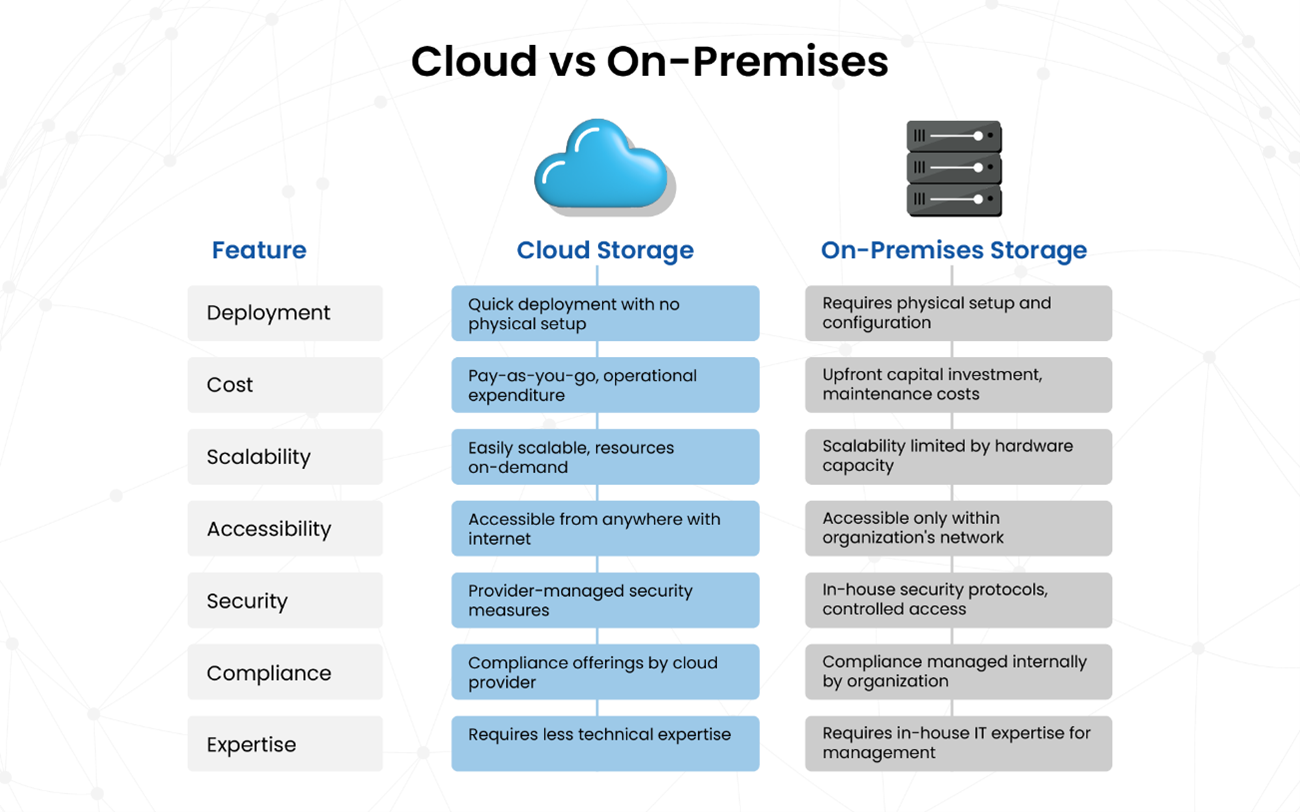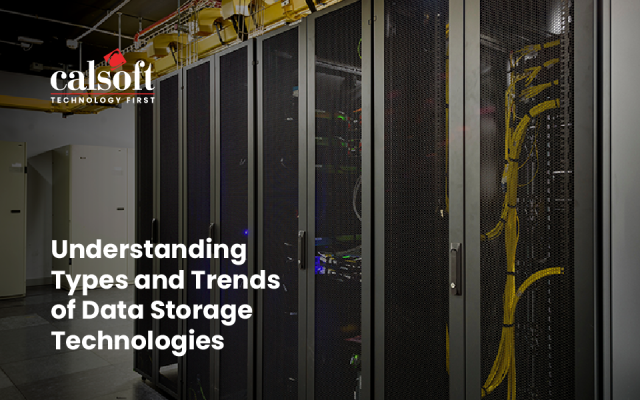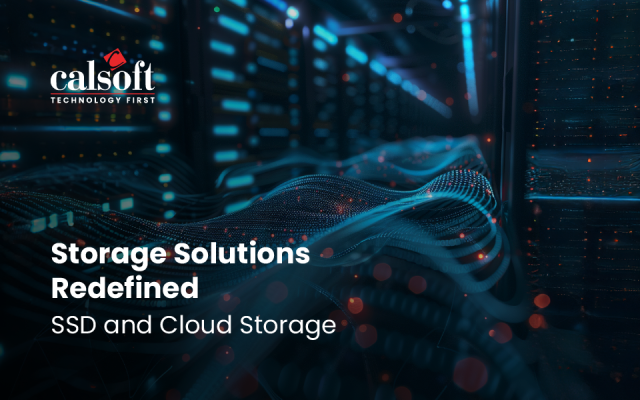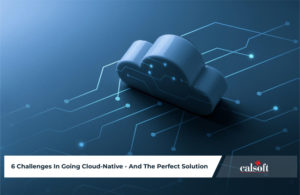Enterprises in today’s digital landscape, be they Large/ Small Medium Enterprises (L/SMEs) or startups, face a perpetual dilemma – how to manage their data, applications, and technology stack.
Should we keep everything grounded, on-premise or should we head for the clouds, store everything in clouds?
When it is the question of deciding the best storage solution for your business the sheer thought can feel extremely overwhelming and complex. Considering the flexibility, benefits, and cost-effective factors, still a large number of small, large, and even medium-sized companies are turning to the cloud for some storage rescue.
Reality check! It’s not an easy decision, various points are debated and discussed when it comes to security, cybersecurity, legacy systems, customization, accessibility, costs, and above all control over the data and technology.
Already much has been written and comparisons are drawn about On-Premise Vs Cloud Storage

The above image compares on-premise versus cloud storage based on certain parameters that most organizations work with – cost, deployment, performance, scalability, accessibility, security, compliance, expertise, operations, redundancy, etc.
However, it is only after arming oneself with the pros and cons of on-premise or cloud storage that CXOs can opt for the right choice keeping in mind the organization’s needs and right fit at the right time. For instance, if the organization has people stationed across several locations across the world, then cloud storage would be more feasible rather than on-premise storage, or even as a start-up with employees across the globe. Or, if an organization is a start-up with a niche product that is local to the region and employees are close to the work location, then the on-premise storage would be a cost-effective solution. However, the pandemic of 2020 proved that even local companies had to ramp up quickly and move towards cloud mainly for quick online accessibility by employees and sharing of information with clients and customers, keeping in mind security too. After listing the pros and cons, a look at the similarities between on-premise vs cloud storage, is imperative.
The two main features include security and cost, further, a hybrid solution could also be a best fit, depending on what aspects are crucial. If data is a must secure, the on-premise works well, but for day-to-day work, cloud storage could be ideal.
Enterprises should focus on the maintenance and management of on-premise storage solutions. This incorporates keeping the hardware updated and assuring seamless and efficient operations. Cloud storage is usually more flexible, scalable, and on demand. In contrast, on-premises storage solutions involve huge upfront costs, with proper maintenance.
Today, enterprises are choosing hybrid storage solutions that combines the benefits of both cloud and on-premise storage solutions. This hybrid solution provides a balance between security, and cost, facilitating enterprises to store highly secure and sensitive data on-premises and non-critical data on the cloud.
Growth of the Cloud Environment
Nonetheless, the cloud environment has proven to be a disruptive technology since Amazon introduced its cloud storage Amazon Web Services in 2006 soon followed by Google, Microsoft, IBM, and Oracle. These 5 giants, known as the hyperscalers, have colonized the cloud space in the digital world and offer large-scale cloud computing capabilities.
Small providers too existed and still do, but soon the shift from selling software that organizations could run on their premises within their own data centers to Software-as-a-Service, SaaS, has rapidly gathered speed. Gartner had predicted that worldwide end-user spending on public cloud services would grow 20.7% to total of $591.8 billion in 2023, up from $490.3 billion in 2022.
And, to stay in this competitive digital environment, with Artificial Intelligence, Blockchain services, immersive web services, and Large Language Models(LLM) all vying to either drown out or liven up the competition, we know that cloud computing is here to stay. How cloud computing grew rapidly and knowing a bit of its history will help understand its growth that forms a background to the emergence of huge enterprise data centers that are required to accommodate the rapid growth of online commerce and applications.
AI and Sustainability: Their Disruptive Role in the On-premise vs Cloud Storage
Global emissions arising from cloud computing range from 2.5% to 3.7% of all global greenhouse gas emissions.
Generative AI applications are incredibly power-hungry to train and use a lot of energy. For more efficient, accurate, and AI predictions, more data and parameters are required which leads to increasing the energy consumption needed to process them.
With a growing shift towards AI, security, costs, and control, are factors that may shift the scene from cloud back to on-premise AI data centers. According to Perry Sui, Area Vice President, ASEAN and Taiwan, Juniper Networks, “Cloud regret is the new story as we hear countless anecdotes of companies repatriating workloads back to private, on-prem data centers.”
The dilemma for enterprises increases!
In today’s world with environmental regulations and the push towards meeting the Social, Development Goals (SDG) to comply with the Economic, Social, and Governance (ESG) policy, enterprises have to literally walk the pirate’s plank!
Technology and innovation have once again shown the way!
There are ways whereby organizations can work towards cloud emission reduction, like optimizing workflows and diverting computing applications to less polluting power grids, and thereby using AI for a more sustainable future.
Caution is nonetheless advised, and organizations would be required to carry out due diligence to ensure that the cloud provider corresponds with their sustainability goals and principles, even though they may brag about their usage of renewable energy and carbon offset programs.
In Conclusion:
On-premise has its drawbacks but given its tried and tested experience, it serves its purpose in terms of Control and Security. Whereas, Cloud storage is still evolving, and with the diverse rules & regulations, and political pressures, organizations will have to weigh the future of cloud adoption, despite the new computing paradigms like quantum and edge computing that can bring about change in the way cloud storage performs and provides for security concerns. Further, the SDGs are ensuring organizations integrate sustainability in their systems and processes, and cloud providers are now made to push for better environmental changes.
Calsoft, being a Technology-First company and a pioneer in software product engineering services, takes on the responsibility and commitment to provide the best analysis for their infrastructure needs and be the change to contribute towards building a safer future in the IT products and services for a sustainable tomorrow.
References:
[1] https://codeit.us/blog/on-premise-vs-cloud-hosting-a-comparative-analysis
[2] https://morefield.com/blog/on-premises-vs-cloud/






